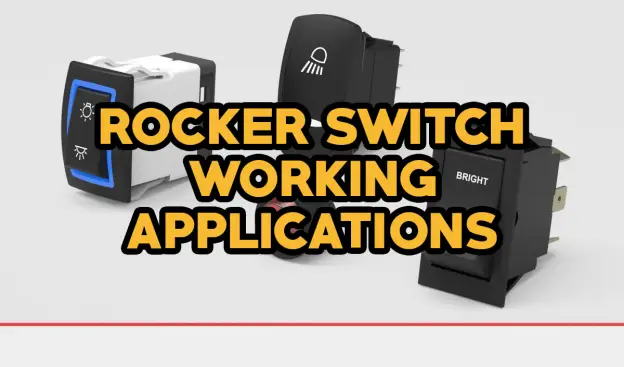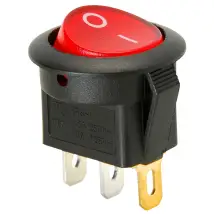

What is Rocker Switch: Working and Its Applications (Full Guide)

What is Rocker Switch
Electrical rocker switches open and close circuits by rocking back and forth, providing a simple and intuitive way to control electrical appliances. A rocker switch is a small, easy-to-use switch that is commonly found in household appliances, vehicles, and industrial equipment. Often featuring wide, flat surfaces to make them easy to operate, their distinctive design makes them ideal for applications that require quick, reliable operation. As a vital component of modern electrical systems, rocker switches excel in a variety of industries, and this comprehensive guide explores their core principles, various types, and diverse applications. ALong with it, you can also learn about CR1220 vs CR1225 and CR2450 vs CR2302 too.
What is Rocker Switch?

Rocker Switch
With rocker switches, electricity is controlled by tilting or rocking the lever from one position to another. An electrical circuit is closed or opened by pressing down on a rectangular or oval actuator. By pressing one end of the actuator, it rocks to the other end, toggling the switch between its two states. Known for their ease of use, rocker switches are commonly used to operate equipment. The status of the switch is often indicated by an illuminated strip, making users more aware of the status of their equipment.
In addition to momentary and maintained contact types, rocker switches come in multiple designs and configurations. Switches of this type are commonly used in household appliances like toasters and coffee makers, as well as industrial equipment and automotive controls. These durable, compact, and easy-to-install devices are popular choices for many electrical devices. Additionally, rocker switches can be customized in a wide range of colors and finishes and can be integrated into a variety of design themes, making them suitable both for functional and decorative uses.
Applications
A rocker switch's ease of use, reliability, and aesthetic appeal make it an ideal component for a wide range of applications. In the following examples, we explain some of the most common applications of rocker switches:
Household Appliances
Many household appliances use rocker switches, including toasters, coffee makers, hair dryers, and fans. Designed for ease of use, these devices can be operated with a simple push. The switches on these appliances are often illuminated to inform the user when they are on, which provides a clear sense of status. Because rocker switches are robust, they can withhold repeated use, making them ideal for appliances that need to be operated frequently. They can also be easily incorporated into appliance designs without compromising aesthetics due to their compact size.
Automotive Applications
Various functions, including headlights, wipers, and power windows, can be controlled with rocker switches in the automotive industry. Vehicles' harsh conditions make them suitable for their durable construction and ability to withstand vibrations. Several automotive rocker switches are designed to be water-resistant, enabling them to perform even in moist or cool environments. Rocker switches provide tactile feedback, enabling the driver to operate essential vehicle functions without losing focus on the road. They improve driver safety by providing tactile feedback.
Industrial Equipment
Machines and equipment controlled by rocker switches require reliable operation in order to function properly. In heavy machinery control panels, these switches allow operators to operate equipment efficiently. High temperatures, dust, and moisture are common conditions in industrial settings, making rocker switches ideal for extreme settings. Manufacturing plants, construction sites, and other demanding environments can benefit from their robust construction. In addition, rocker switches are easy to operate and clearly labeled, reducing the risk of errors in high-pressure situations.
Marine Applications
Lights, pumps, and other onboard equipment are controlled by rocker switches in marine applications. Boats, yachts, and other watercraft can use them since they are designed to be waterproof and durable. Despite rough seas or adverse weather conditions, rocker switches are easy to operate because of their ergonomic design. It is also essential for safe navigation and operation on the water that marine rocker switches are illuminated to provide visibility in low-light situations. Boat manufacturers and marine equipment suppliers prefer them because of their reliability and durability.
Outdoor and Garden Equipment
Power tools, lawnmowers, and lighting systems are often controlled with rocker switches used in outdoor and garden equipment. Rain and humidity are not a problem for their weather-resistant design. Equipment can be started or stopped rapidly with rocker switches, providing a simple and intuitive way to operate. In addition to illuminated rocker switches, many outdoor applications also utilize these switches for improved visibility and improved location in low-light situations. Users who operate equipment early in the morning or late at night will find this functionality especially useful.
Furniture and Home Decor
There is an increasing use of rocker switches in electronic devices, lighting, and other items of home decor. Providing a modern aesthetic while maintaining functionality, their sleek design integrates seamlessly into furniture designs. With rocker switches, users are often able to switch on/off their lamps easily, often by gently touching them. Designing a home environment with rocker switches enhances user experience while maintaining a cohesive look due to their versatility in design and functionality.
Computer and Electronic Devices
Computers, gaming consoles, and audio equipment all use rocker switches as part of their consumer electronics. They are suitable for power management and function control due to their tactile feedback and straightforward operation. Rocker switches provide reliability for many electronic devices because they can withstand frequent use without failing. Further, due to their compact size, they are able to be incorporated into sleek, modern designs while offering users a simple means of controlling their electronic devices.
Medical Equipment
Medical equipment also uses rocker switches for precise control and reliability. Rocker switches are often used to adjust settings on hospital beds, imaging equipment, and patient monitoring systems. Safety standards ensure that these switches can withstand repeated use in clinical environments. Healthcare professionals can operate rocker switches quickly and efficiently due to their intuitive design, which improves patient safety and medical care effectiveness.
Working Principle
Rocker switches are designed mechanically, and their actuator moves according to a simple principle. An electrical circuit can be opened or closed by rocking a lever back and forth. The following are the steps involved in operating a rocker switch:
Structure and Components
There are several components that make up a typical rocker switch:
- Actuator: The user interface is usually flat, rectangular, or oval-shaped and is usually visible on the switch. When the actuator is pressed, it tilts or rocks.
- Base: This part of the switch houses the electrical contacts and other internal components.
- Electrical Contacts: Circuits are closed or opened by these conductive parts. The "on" and "off" positions are normally marked by two pairs of contacts.
- Spring Mechanism: When pressed, the actuator is returned to its original position by a spring.
Mechanism of Operation
The operation of a rocker switch can be broken down into the following steps:
Actuation
Rocker switches pivot around a central point when a user presses down on one end. Rocker switches differ from toggle switches and push-button switches by rocking back and forth. Actuator design causes the opposite side to rise when one side is pressed down.
Contact Engagement
As the actuator rocks, it engages the electrical contacts through the internal mechanism. One set of contacts closes when the actuator is moved, while the other opens.
- On Position: Actuators bring electrical contacts together when they are pressed down, completing a circuit and allowing current to flow through the device. "On" refers to this position.
- Off Position: As soon as the actuator is released, the spring mechanism returns it to its original position, which opens the contacts and interrupts the flow of current. Switches are returned to "off" by this action.
Circuit Control
There are two main configurations of rocker switches: single-pole single-throw (SPST) and single-pole double-throw (SPDT).
- SPST Rocker Switch: Electrical devices can be controlled with this type of switch, which has two positions, "on" and "off."
- SPDT Rocker Switch: Depending on where the switch is positioned, this variant can route power between two circuits.
Final Verdict
Modern electrical systems require rocker switches to control a variety of devices across an array of applications, making them essential components. With their simple operating principle and intuitive rocking motion, these actuators are ideal for residential and industrial applications alike, providing easy operation and clear feedback. Industrial machinery and medical equipment, as well as household appliances and automotive controls, benefit from rocker switches for their functionality and safety. Further solidifying their place in both functional and decorative applications is their durability, compact design, and aesthetic versatility. Rocker switches, which contribute to enhanced user experience and operational efficiency, will remain a key player in electrical control systems as technology advances.
Subscribe to JMChip Electronics !



















